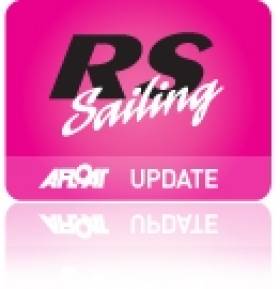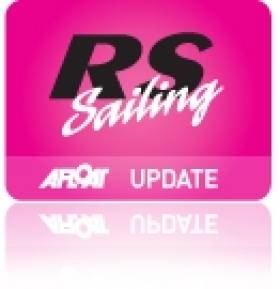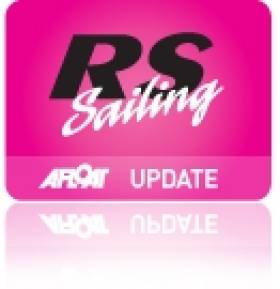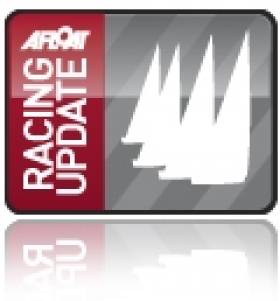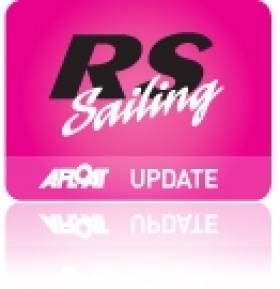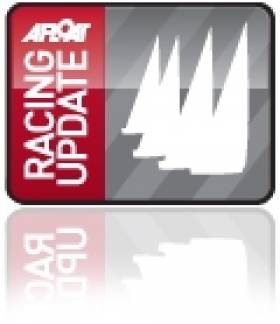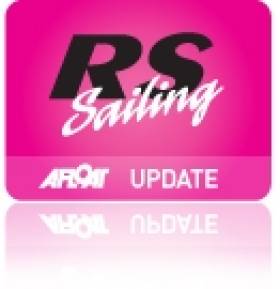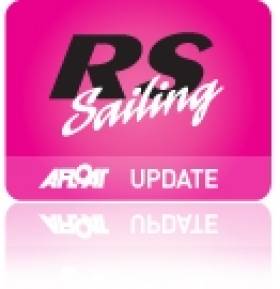Displaying items by tag: RS
Irish RS Fleet Publish Six Fixture Dates for 2012
#RS – There’s a busy year afloat in prospect for the rapidly expanding Irish RS400 and RS200 dinghy sailing fleets with six events scheduled for the 2012 season. A five event traveller series kicks off with the Inlands at Lough Ree on the 28th and 29th of April. The Nationals take place in Howth on the 17th-19th of August and the season rounds off with the Sprint Trophy series in Dun Laoghaire in October. For those who feel adventurous, the RS Eurocup takes place on Lake Garda in July.
Next season also sees the RS Feva’s combine with the RS400’s and RS200’s for several events. In addition to the racing events, a number of coaching sessions will be run at various clubs throughout the year.
Irish RS Association 2012 Calendar
|
28th – 29th April |
Inlands |
RS400 RS200 Feva |
Lough Ree YC |
|
30th June - 1st July |
Easterns |
RS400 RS200 Feva |
Newcastle YC |
|
17th - 19th August |
Nationals |
RS400 RS200 Feva |
Howth YC |
|
15th - 16th September |
Northerns |
RS400 RS200 Feva |
Strangford Lough YC |
|
6th - 7th October |
Southerns |
RS400 RS200 Feva |
Greystones SC |
|
20th October |
Sprint Trophy |
RS400 RS200 |
Royal St George YC |
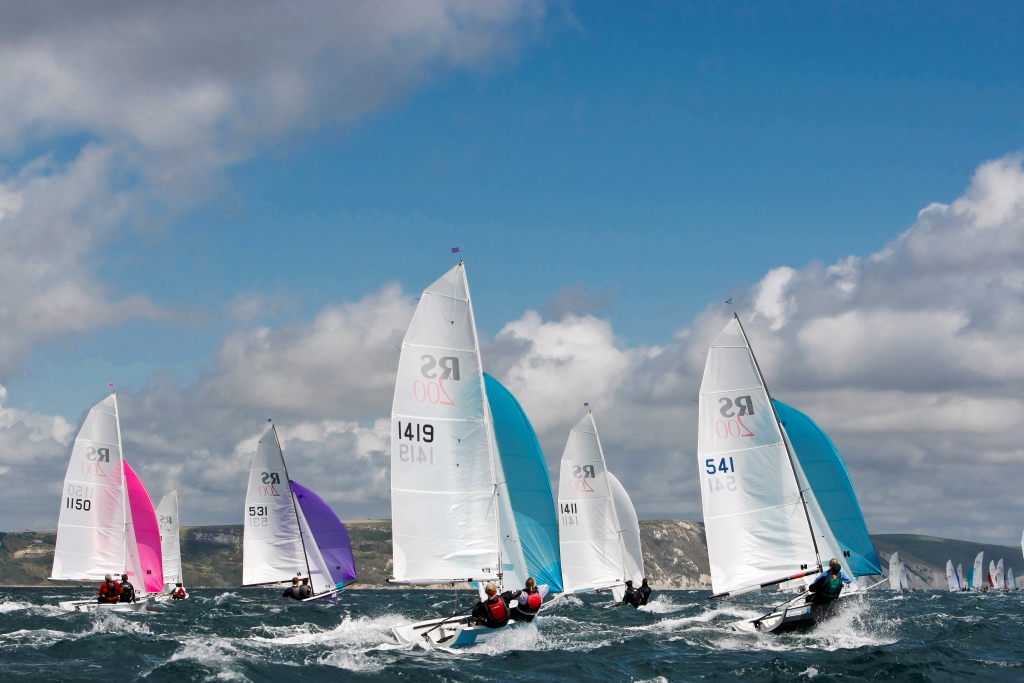
RS dinghies sailing at full speed
RS Boat Builder Reveals New Women's Skiff
#SKIFF – Testing of the production specification RS900, RS Sailing's contender for selection as the new women's Olympic skiff, is underway. It's a sleek looking affair as you might expect that will take women's sailing into a whole new area because it has been designed especially for lighter crew weights.
"We believe that a new generation of elite skiff sailors deserve a purpose designed boat that will excel in the role and stand the test of time" says RS managing director, Martin Wadhams. "After several changes to the women's classes over recent Olympic cycles, the last thing anyone wants is another short term measure. We began the process several years ago believing that the RS800 could be modified to become the women's skiff, but quickly realised that although it was arguably the most suited of the then current bunch, it would never be perfect for Olympic women. So our own RS team of Alex Southon and Nick Peters has worked with Phil Morrison to start from scratch and design the RS900 without compromise."
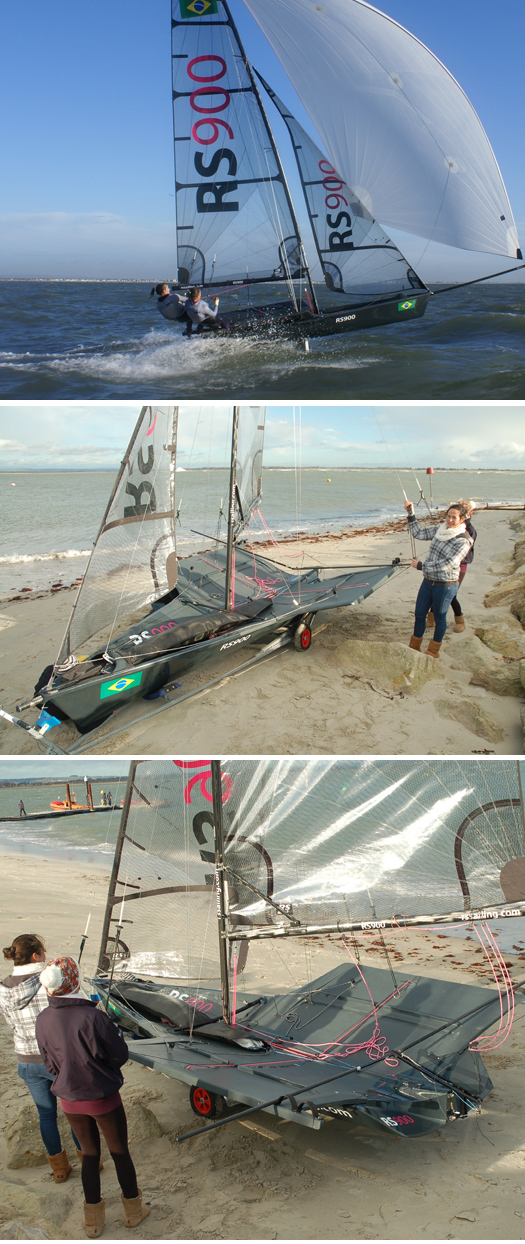
The RS900 hull is shorter, narrower and has lower freeboard – smaller all round to suit light female teams. The reduced surface area allows a corresponding weight reduction whilst using a similar long lasting, epoxy foam sandwich construction system to the 800.
Fully integrated wide, solid wings and a smooth run-through deck on the RS900 facilitate athletic sailing. RS900 sailors will use techniques matched to those of the 49er men, allowing shared training in many regions, especially helpful for smaller sailing nations. As you can see from the photos, the wings fit smoothly into the hull providing arguably the most flowing platform of any skiff, plus structural integrity and seriously good looks.
Structural engineering has played a major part in the design development of the RS900. RS technical director Alex Southon has significant, hard-won, volume production experience and he has enlisted input from world class composite engineering experts in the USA on this project to help him create a boat that is not only strong and long lasting, but also efficient to build. This will keep costs low for a skiff of this type and the RS900's price will in line with a competitive 470 rather than the similarly high performance 49er!
The rig is matched to wide leverage to produce spectacular performance whilst suiting the110 -130kg crew weight range specified by ISAF. The jib is tacked onto the bow, with the forestay attachment point pushed as far forward of the forefoot as possible to give maximum low-down jib area, without excessive hull length and correspondingly reduced responsiveness. The relatively straight mast and square head mainsail follow the latest skiff design trends and, of course, a masthead spinnaker maximises downwind performance.
RS Sailing has the proven ability to produce a large number of epoxy racing dinghies quickly - last year around two hundred RS100s were built and delivered to destinations across the globe within 12 months of launch. Their international dealer network provides back-up support with parts and sails.
Final testing of RS900 will continue over the coming months in the run up to ISAF's evaluation trials which are expected to be held in March 2012, although as Alex Southon says "We're talking about details now from a development perspective. The 900 works and all the sailors who've been in it so far are really excited – so we'll just keep tweaking the rig and getting miles under the hull until we have to stop!"
Inaugural RS400 & RS200 Sprint Trophy Preview
In the RS200 class National Champions Roy Van Maanen and Glen Reid will come into the event as favourites. However, the entry of the husband and wife team of Sean and Heather Craig of the Royal St George is sure to mix up the class status quo.
Heather Craig has already scored a very impressive 2nd at this year's RS200 Nationals, which were held at Cushendall. Sean Craig is sure to apply all of the asymmetric spinnaker skills, which he has honed in the Sb3 class to full affect on home waters.
The unassuming young Greystones pairing of Sean Cleary and Steven Tyner are the dark horses of RS200 fleet. They have been gradually climbing the ranks of the class since they made the transition up from RS Feva. They have already applied what they have learned in the Fevas at this years Nationals in Cushendall taking 3rd place overall.
In the RS 400 fleet, a strong contingent from the Royal North of Ireland Yacht Club is expected to put up a challenge to the dominance of the Greystones based National Champion Simon Herriott. The Royal North pairing of Michael McAllister and Michael Patton are sure to feature, after finishing 2nd at the Nationals. Michael McAllister is on winning form. He was part of Peter Kennedy's team, which won last weekends Sb3 Midland Championships.
Liam Donnelly and Andrew Vaughan have plenty of experience onboard and will relish the prospect of the breezy forecast.
There are also some new faces making their debut the 400 class. Wayfarer national champion Trevor Fisher has teamed up with the very capable Selina Dicker. This team could prove to be a potent combination. Selina has a wealth of asymmetric experience from her time on the UK Laser 5000 circuit.
Bernard Fitzpatrick of the Royal Cork Yacht will also make his RS400 debut. Bernard was a vital part of Mark Mansfield's 1720 European Championship winning crew and has spent the last four seasons as bowman on the international Melges 32 circuit. He is looking forward to the event as his first chance to race in the RS400.
Making his long awaited return to the RS400 class is Dave Cheyne. Dave is looking forward to combining next years RS Traveller series with his Sb3 class commitments.
Please see these Youtube videos below, which give an idea of what to expect from the RS boats. However the weather featured in the videos is unlikely to be repeated for this weekend. See if you can spot the cameo from our own Dave Cheyne in the RS400 clip.
RS400
RS200
For information on the RS Sprint Trophy e-mail [email protected]
RS Duo Lead Endeavour Trophy
RS200 national champions Peters and Roberts sailed an impressive series in today's testing conditions and lead this champions of champions event by just one point from OK national champion Nick Craig and Toby Lewis.

Peters and Roberts Lead Endeavour Trophy. Photo: Sue Pelling
Racing, over short-sharp, windward/leeward courses, in the gusty 14-16kt north-westerly breeze, at the mouth of the River Roach a couple of miles down stream from the host club, Royal Corinthian Yacht Club, kept the fleet on its toes throughout the day and the level of competition – with national champions from 25 of the most popular dinghy racing classes represented – was, not surprisingly, extremely high.
At just 20 years old, this is Peters' first time at the Endeavour Trophy, which makes his leading performance even more creditable. Chatting as he sailed ashore after a tough day on the water, Peters commented: "We are really happy with how we sailed today. Obviously it is a really tough event with loads of really high quality sailors here, so we were happy to put in some consistent results, and we had really good fun as well. Interestingly we've never sailed a Topper Xenon before but I have to say we are impressed. After five races we feel we are just about getting used to it."
Endeavour veterans Craig (who's won the event four times before) and Lewis, know from experience that with three races left to sail, there's a long way to go. Commenting after racing Craig said: "It was fantastic racing, and we really, really enjoyed it, despite it being such hard work. With five, 45-minute races today, we really 'got out money's worth'. We are looking forward to a bit more wind tomorrow. However, we are going to have to watch young James and Alan though, they are really sailing well. They make us feel like old men!"
Andy Davis and Tom Pygall representing the Merlin Rocket class kick started this year's event in race one today, with some spectacular sailing which pulled them through the fleet from ninth on the second beat an overall race win with Peters and Roberts in second. Competition is so high, however, that even with a 1,5 to count they are still in seventh place.
Stuart Bithell and Christian Birrell – last year's Endeavour Trophy winners – are back again this year, but having each won independent class championships, they are in separate boats. Both talented young helmsmen, it is not surprising to see them both atop the score sheet with just four points between them at close of play today. Bithell, representing the GP 14 class is sailing with Matt Johnson and is lying in third place overall, while Enterprise champion, Birrell, sailing with Sam Brearey is lying sixth.
Scorpion representatives, Tom Jeffcoate and Mark Hogan, notched up some consistent results including a couple of third places, which leaves them fourth place with three races remaining.
The forecast is for the wind the wind to increase tomorrow for the final three races of the series. Race officer, Kim Allen, is keen to get the racing underway as soon as possible at 1030 which means a new Endeavour winner should be revealed by 1500.
This evening, competitors and guests are attending the annual, grand Endeavour dinner at the Royal Corinthian Yacht Club, and last year's winners, Stuart Bithell and Christian Birrell are giving a speech.
Special thanks to the Endeavour Trophy sponsors which include the following: Topper, Allen Brothers, Calltracks, Hyde Sails, Selden, English Braids, Petticrows, Musto, Noble Marine.
Results (after 5 races, and 1 discard)
1st RS200 – James Peters and Alan Roberts 7pts
2nd OK – Nick Craig and Toby Lewis 8pts
3rd GP14 Stuart Bithell and Matt Johnson 17pts
4th Scorpion – Tom Jeffcoate and Mark Hogan 18pts
5th Osprey – Matt Burge and Richard Wagstaff 19pts
6th Enterprise – Christian Birrell and Sam Brearey 21pts
For full results visit: www.royalcorinthian.co.uk/endeavour-championship
Greystones Lead Both Fleets in RS 200/400 Irish Nationals
The championships, which were sponsored by Neil Mathews Architects, saw 18 RS400 boats and 13 RS200s enter. There were five races held over Friday and Saturday, while gusts of nearly 40 knots saw Sunday's races abandoned.
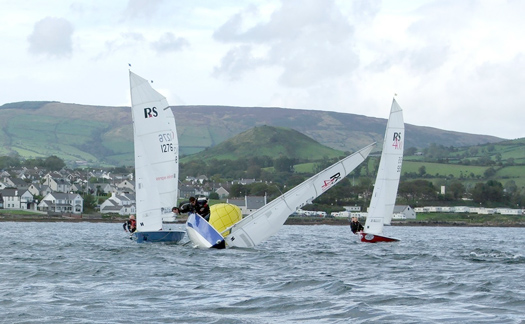
Local sailors John Lowry and Neil Diamond attempt to right their capsized RS400, while Greystones' Fiachra Etchingham and Eoghan Simpson pass the mark at the RS200/400 National Sailing Championships in Cushendall at the weekend
Roy Van Maanen and Glen Reid from Greystones Sailing Club led the RS200 fleet, bagging three firsts, a second and a third. In second place were Trevor Fisher and Heather King from Royal St George Yacht Club in East Down. And then it was Greystones again, with Sean Cleary and Steven Tyner amassing a first, second, third and two fourth place finishes to end up in third place overall.
Paul McLaughlin and Mick McKinley were first home from the five local crews that took part in the RS400 class, finishing fifth overall.
Gerry and Avril Cannon lifted a prize as the first mixed crew home in the 400s, while Sarah and Ciara Byrne in an RS200 were the first all-woman crew home.
Richard Doig and Dr Michael Hill from East Antrim Boat Club kindly officiated as Race Officer and Assistant Race Officer for the series.
Tight Competiton for Squibs, SB3s and Elites at Royal North
Royal North of Ireland Yacht Club has completed its keelboat fixture sponsored by Brewin Dolphin consisting of three fleets; RS Elites, SB3s and Squibs, racing six races over two days. The RS Elites was the joint largest fleet this year made up mostly of local boats and two visiting Elites from Ocean Youth Trust. The Squibs were next in numbers, followed by The SB3s.
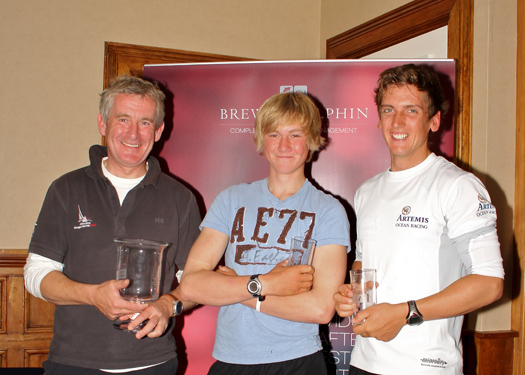
RS Elite Class Winners Simon Brien, Jack Brien and Ryan Seaton
Simon Brien on "Kin" was to rule the Elite class, and he found he was going to have to fight for it. On Day one, his brother Mark on "Full Marks" was covering him tack for tack and very little separated them on all three races. John McDowell' "Sea Breezes" [From Carrick] was also on the pace and finished the day one point behind "Kin". Bob Espey and Matt McGovern [Ballyholme] on an Ocean Youth Trust Boat was also consistently at the top of the fleet.
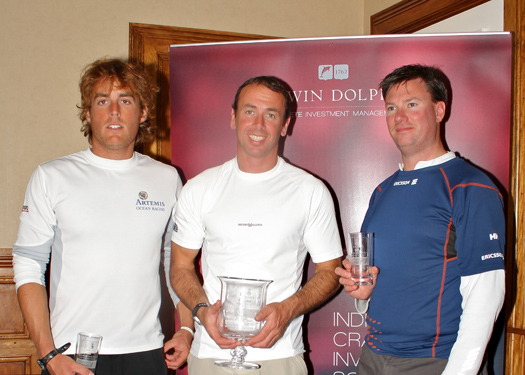
SB3 Class Winners Gareth Flannigan Ross Nolan and James Espey
The SB3 fleet also had it tight, day one saw a battle between Gareth Flannigan on "Splash Gordon" with James Espey and Ross Nolan on board match race with Peter Kennedy on "Ridge Fence" both boats finishing the day on equal points, followed closely by Trevor Darcy and Andrew Vaughan on "Bullet" on 8 points. On the Squibs, Greg Bell was out to flex his mussels on his new Squib "Prodigal" against him was Sam Lyness on "Worm" and Peter Wallace on "Toy for the Boy". The first race went to "Worm" with "Toy for the Boy second and "Prodigal" third, however a later protest was to knock "Worm" of her top spot and allowed everyone else to slide up one place. Race two also went to "Worm" followed by "Prodigal" and "High Flyer" in third. The third race again saw a change in the top spot this time "Toy for the Boy" taking pole. By the days end yet another fleet had two boats tied on points for the top spot, "Prodigal" and "Toy". Sundays racing was postponed for an hour to allow for the wind to fill in, and this was welcomed by many of the competitors due to lots of revelry the night before.
A fresh southerly breeze filled in and allowed Principle Race Officer Neale McCullough to get racing under way. Royal North's Commodore Mike Vaughan took race four in the Elite Fleet with "Kin" second and "Full Marks" third.
The fifth race "Kin" was back to her number one slot with the Vaughan's second and Andrew Allen's "No Match" third. The last race in the Elite fleet had to be seen to be believed as each boat tacked up the beat, each boat having to dip a boat that had dipped them on the previous tack and vice versa, by the top mark an d spreader mark they were bumper to bumper only a few inches separating them they looked like a train!
Eventually Simon Brien's "Kin" took the line honours and the series followed by Mike Vaughan's 64 and John McDowell's "Sea Breezes" in third overall.
In the SB3 fleet the second days racing saw no let up in fierce competition between Gareth Flannigan and Peter Kennedy in the end the series went to Flannigan's "Splash Gordon" with Kennedys "Ridge Fence" one point behind and Trevor Darcy's "Bullet third over all.

Squib Winners Greg Bell and Leah Anderson
Race Four for the Squibs gave Greg Bell his first win of the series with Des Clayton on "Inishmara" second and "Worm" third. All change again for race five this time the Anderson brothers "Born Wild" took the bullet followed by the worm and Gordon Patterson's "Quickstep" third. All was to play for in the last race as the series top three places was wide open.
In the end Sam Lyness won the race and secured him a second place overall. "Quickstep" took second giving them a fourth overall. Johnny Parks "Gizmo" finished third in that race quite satisfactory for the Squib newcomer. But the Series top spot went to Greg Bells "Prodigal" on twelve points one point ahead of "Worm" and "Toy for the Boy" third overall on 16 points.
The Commodore of Royal North Mike Vaughan thanked the sponsors Brewin Dolphin and all those who had been involved in the event, he commented on the extremely close racing in all fleets but especially in his own fleet the
Elites which were extraordinary!
RS Fleets Gather in Cushendall
The RS200 and 400 are modern, high-performance two-man sailing dinghies, with the RS200 suiting lighter and younger crews. The boats have developed a huge following and competitive fleets across Ireland and the UK, with Wicklow's Greystones Sailing Club alone due to bring five 'under 18' boats and more boats for other young people to Cushendall this weekend.
CSBC Commodore John Lowry said: "The RS400s and RS200s are a great fleet, providing very fast and exciting racing. We had them for a competition around this time last year and it was fantastic. With this being the National Championships, we're expecting an even bigger fleet as well as some visitors from across the water. After racing in the evenings, we've lined up some great catering and live music so this should be a great event. As a competitor myself in this type of boat, I'm especially looking forward to it. According to the weather forecast, it looks like sailors will be treated to a wide range of wind conditions this weekend – as well as the Cushendall hospitality that we have become known for."
RS Sailors Heading North to Cushendall
The 2011 RS400 and RS200 Traveller Series draws to a close this weekend with the National Championships taking place at Cushendall Co. Antrim.
Two strong fleets of over 40 boats in total are expected.
In the RS400's Simon Herriott of Greystones SC, who scored some very impressive top ten results in the 86 boat UK Nationals is going to have some notable competition with the recently crowned Irish Fireball National Champions and Cushendall locals Barry McCartin and Conor Kinsella rumoured to be entered.

Greystones SC is bringing five 'under 18' boats and more boats for sailors in their late teens /early twenties to Cushendall this weekend. The Club's hard work getting kids into fast doublehanders is bearing fruit. See more on this initiative here. Photo: Sarah Byrne
Also bolstering the fleet is multiple Laser regional champion Paul McMahon, who also has plenty of asymmetric experience from his time in the SB3 fleet. Along with the Irish contingent some of the hotly contested UK fleet may make the trip across.
In the RS200 fleet the season long battle between Greystones rivals Roy Van Maanen and Graeme Noonan is set to continue. But the Wicklow 200's may not have it all there own way, with Clive Coffey and Emily Smith sure to be contention.
RS 200: the 'ideal' next step for Irish Youth Sailing?
Questions over the next step for juniors after the RS Feva point to the bigger RS200 writes Feva sailor Ciara Byrne
The RSFeva has become the world's best selling two-person dinghy in recent years with fleets also growing in clubs all over Ireland. It is fast becoming the most popular and widespread choice for teenagers and youth sailors who enjoy competitive, active and exciting sailing.
However many questions were being asked recently at the RSFeva Nationals, held in Crosshaven, Co. Cork, regarding the next step for young, talented sailors who wish to continue racing in large fleets without the difficult transition of transferring from the Feva into a larger, unfamiliar dinghy. This uncertainty has led to many sailors dropping out of sailing altogether, while the remainder have split the fleet into Lasers, the 420/470 or moved on to cruisers.
However these dinghies require a lot of time and effort of getting used to, leaving some sailors frustrated and also, less motivated. To avoid this altogether, there is one simple solution: the RS200.
The RS200 is a spacious, one-design, double-handed, hiking, high-performance dinghy which has developed a huge following at club, circuit and championship level in the UK with a growing fleet in Ireland. A pivoting centreboard and rudder allow easy launch and recovery with a thwart giving the crew a comfortable position for light winds. With the asymmetric spinnaker, similar rigging and a similar design, it can be considered as a larger and faster Feva which makes for an easy changeover and the most logical and simple step up.
The ideal weight for an RS200 is 115-145kg (18-23 stone) which allows people of all ages to sail and race effectively in this dinghy. Ideal for teenagers emerging from the Feva, parents, youths, couples, friends and relatives can also come together which enhances the family and social scene.
Even though the 420 has a larger total sail area, the RS200's asymmetric spinnaker of over eight square metres, with a smoother single line hoist and drop system, similar to the Feva's. makes for a faster boat and requires greater tactical and more exciting downwind sailing. This encourages competitive racing and enhanced racing skills.

An RS200 at full speed off Greystones. Photo: Fiachra Etchingham
A maintenance free hull, made of lightweight polyester GRP ensures a long competitive life and second hand boats can be in very good condition so that older hulls are without the disadvantage experienced in fleets such as the 420. Furthermore, every hull comes from the same manufacturer giving no subtle advantage to any one boat; therefore racing just comes down to the sailors' tactics, boat handling and general knowledge of sailing and racing.
While the RS200 is not an Olympic class, there are large UK and Irish fleets which are active and competitive. Johnathan Lewis, a UK Feva coach and RS200 sailor, strongly encourages Feva graduates to move into the RS200 as it is an easy transition and makes for fun and exciting sailing. RS200 fleets are strong in Irish clubs such as those in Northern Ireland including Ballyholme, Newcastle and Cushendall as well as Greystones Sailing Club in Co. Wicklow.
Greystones Sailing Club boasts probably the largest asymmetric dinghy fleet in Ireland with fifty five asymmetric dinghies, twenty one of those being RSFevas and the majority of the remainder being RS200s. Recognising the RS200 as the natural progression from the Feva, ages range from fifteen to fifty five across the RS200 and RS400 fleets in the Club, with most of these boats competing in national events in Ireland, and some in the UK and further afield.

Rounding a mark in the RS200. Photo: Fiachra Etchingham
As fleets build in Dún Laoghaire and Howth yacht clubs, the RS200 is gradually becoming a popular progression from the Feva, and with the RS400 as a follow on boat for larger crews, young sailors can remain involved and spirited in asymmetric racing. The RS200 satisfies a thirst for speed and pace which generates more exciting, competitive and enjoyable sailing for those emerging from Feva fleet.
A Dublin Sailor (who has asked not to be named) has sent us comments on this story:
As one involved in junior and youth sailing at club level, one of the big decisions that faces youths is where to go after junior classes such as Optimists, Toppers, Fevas. Like any other sport, there is a high attrition rate after the age of 14 / 15, especially among girls which is an even greater shame as they can compete on a par with the guys.We need a class that will keep youths engaged. The 420 & 29er are great boats but require higher levels of boathandling, are much more competitive and tend to attract the top sailors. They also suffer from an inability to match up crews who will stick together - teenagers chop and change all the time and its difficult to race a boat like a 420 / Fireball / 29er wihout a constant crew partnership.
We need a boat/class that:
- Enables swapping around of crews without a major impact on the boathandling / teamwork. A sailor's plans for the weekend / event / season are not scuppered because of crewing issues.
- Does not need a highly competent crew (e.g. ability to trapeze and fly / gybe a kite etc.) so that sailors can sail with their mates who may not necessarily be top-notch sailors but who can acquit themselves well in a slightly less complex boat.
- Has a good mixed social scene which is the most important element of any class, youth or otherwise.
- Does not cost the earth in terms of purchase price, is easy on wear & tear on kit (hence replacement & upgrade costs) or does not go soft and become uncompetitive needing a new hull after three to five years etc
- Has international competition that is closeby (UK, FR, Bel, Ned etc) for those aspiring to a bit more
- Has a motiviated class structure to help grow the class.
The fear is that we are starting out another class that will dilute the current youth class efforts. However I believe that the 420 and 29er will hold their own and continue to attract top sailors with ISAF ambitions.
On the other hand, if we continue to support these we will continue to lose the middle ground (and majority) of young sailors from our sport. Youths are fickle enough and if its too much hassle to deal with all the challenges of getting afloat they just won't bother - sad but true.
The ISA needs to take a lead in this and while its Olympic ambitions are great to see, it will fail the sport as a whole if it does not tackle this gaping need in its portfolio of support.
I believe that the RS200 and R2400 provide the best solution to these challenges. They appear well-built and the manufacturer certainly appears well organised and gets involved.
Looking from outside and without any vested interests (other than the health of junior and youth sailing) the RS's get my vote as a class that can make a radical difference.
Howth Juniors Win 19-Boat Greystones Feva Event
Seven races were sailed and Howth visitors David Johnston and Louise Flynn Byrne emerged clear winners from Dun Laoghaire's Stephen Judge and Patrick Riordan by a margin of 12 points. Full results here.




























